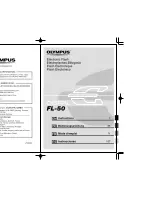
129
Appendix
.
Precautions during Use
• Operation provided by a battery under cold conditions is always less than operation
under normal temperatures. This is due to the characteristics of the battery, not the
camera.
• Charge the battery in an area where the temperature is within the range of 5°C to
35°C (41°F to 95°F). Outside this temperature range charging can take longer than
normal or even fail.
• Do not tear or remove the battery outer label.
• If a battery provides only very limited operation following a full charge, it probably
means the battery has reached the end of its service life. Replace the battery with a
new one.
.
Storage Precautions
• Storing the battery for a long time while it is charged can cause deterioration of
battery characteristics. If you do not plan to use a battery for some time, fully use
up its charge before storing it.
• Always remove the battery from the camera when you are not using it. A battery left
in the camera can discharge and go dead, which will require some time to charge
when you need to use the camera.
• Store batteries in a cool, dry place (20°C (68°F) or lower).
• To prevent over discharging of an unused battery, fully charge it, and then load it in
the camera and fully use up the charge about once every six months.
.
Precautions during Use
• The bundled charger is designed for operation with any power supply in the range
of 100V to 240V AC, 50/60Hz. Note, however, that the shape of the power cord
plug depends on each country or geographic area. Before taking the camera and
charger along on a trip, check with travel agent about the power supply
requirements in your destination(s).
• Do not connect the charger to a power supply through a voltage converter or
similar device. Doing so can lead to malfunction.
.
Extra Batteries
• Taking along extra fully charged batteries (NP-80) is recommended while on a trip
in order to avoid not being able to shoot images due to the battery going dead.
Battery Precautions
Using the Camera in another Country
















































